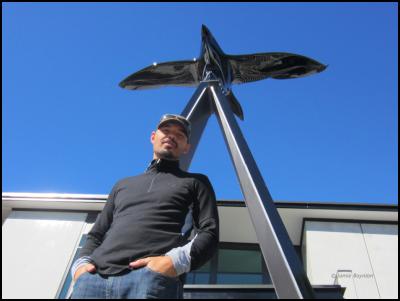Artist’s symbolic Manu lays down wero to all who enter
Media Release: Te Whare Wānanga o Awanuiārangi:
indigenous-university
12 April
2013
Artist’s symbolic Manu lays down wero to all who enter
A five-metre illuminated sculpture of a symbolic bird stands as a modern wahanui (gateway) to Te Whare Wānanga o Awanuiārangi: indigenous-university’s new Whakatāne campus.
Manu (bird), a jet-black fibreglass sculpture by contemporary Māori artist Jamie Boynton (Ngai Tūhoe, Te Whakatōhea) is one of the cutting-edge artistic and cultural elements that feature at the Wānanga’s striking new facility. Manu is a metaphor for the challenge laid down by Awanuiārangi to its students, Boynton says.

Caption:
PUSHING THE
BOUNDARIES: Opotiki artist Jamie Boynton with Manu,
outside Te Whare Wānanga o Awanuiārangi’s new campus in
Whakatāne.
“The manu is leaning forward, and its beak is open as it challenges those who enter to spread their wings and fly, using the Wānanga as their waka.”
The sculpture sits at the apex of two adjoining legs representing the tauihu (double hull) of Mātaatua waka as a symbol of unification. It relates to the story of the two manu, Mumuhou and Tākeretou, which led the waka to Whakatāne.
“That kōrero captured my imagination. It presented a perfect metaphor for what the wānanga is striving to achieve, which is to empower our people and inspire them to spread their wings, to step out and strive for new and great things. It relates to the Wānanga’s vision and guiding whakataukī – to pursue knowledge to the greatest depths and broadest horizons.”
“The sculpture symbolises the energies of those two guiding manu rather than being one or the other. There are differing stories and perspectives on those birds, so the underlying meaning and values are what I focused on.”
The concept also fit perfectly with the techniques Boynton had been exploring, particularly using light to represent mauri (life force) as part of the sculptural form.
“I like to work with light and glass. It’s a really lovely way of illustrating the spiritual aspect, which is difficult to portray because it is non-physical. You can create a really strong sense of wairua through the use of glass, light and reflection.
“My work is about re-igniting the wisdom of our ancestors in a way that inspires future generations. It is taking the ancient art of whakairo and considering how we can move forward and remain leading edge.
“I also wanted to get away from what you expect a wahanui to be. Most wahanui involve carvings of ancestral figures. This is a departure that expands the concept and pushes the boundaries.”
Manu is illuminated at night, projecting coloured light through whakairo patterns on the undersides of the wings. This is achieved using eight LED lights inside the hollow fibreglass mould. Measuring five metres from wingtip to wingtip, and weighing about 300kg, the sculpture was formed around an internal frame of aluminium and took shape over more than six months in the artist’s studio.
Boynton said one of the fascinating aspects was researching materials.
“I looked to the marine industry because it deals with the most extreme environments and part of my brief was to create something that would last at least 50 years.”
He consulted America’s Cup yacht suppliers, and the team at Browne & Smale Panelbeaters in Opotiki painted and coated the sculpture using materials and techniques recommended by them.
Boynton says the project was hugely exciting and challenging.
“It stretched me far beyond what I thought I was capable of. It’s about exposing communities to a different viewpoint, a Māori viewpoint: broadening perspectives of what ‘Māori’ is – and also broadening Māori perspectives of what ‘Māori’ is. It’s also about moving our culture forward by contemporising our stories and traditions.”
ends


 UCOL: UCOL Ākonga Awarded $28,000 In Freemasons Willson Lewis Scholarship
UCOL: UCOL Ākonga Awarded $28,000 In Freemasons Willson Lewis Scholarship Auckland Museum: Auckland Museum Announces Inaugural Matafatafa Aho Pacific Artist In Residence
Auckland Museum: Auckland Museum Announces Inaugural Matafatafa Aho Pacific Artist In Residence PHARMAC: Pharmac To Fund Medicines For Blood Cancers, Inflammatory Bowel Disease, Eczema And Arthritis
PHARMAC: Pharmac To Fund Medicines For Blood Cancers, Inflammatory Bowel Disease, Eczema And Arthritis  NZ Principals Federation: Principals Support NZEI's Call For Learning Support Boost
NZ Principals Federation: Principals Support NZEI's Call For Learning Support Boost NPDC: A Century On Stage - TSB Showplace To Celebrate 100 Years With Spectacular Show
NPDC: A Century On Stage - TSB Showplace To Celebrate 100 Years With Spectacular Show Dame Malvina Major Foundation: Kiwi Opera Star Emmanuel Fonoti-Fuimaono Joins The Royal Opera, London
Dame Malvina Major Foundation: Kiwi Opera Star Emmanuel Fonoti-Fuimaono Joins The Royal Opera, London